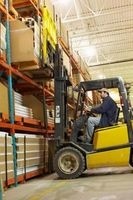Forklift Safety Checklist

Workers at construction sites, retail stores and warehouses use forklifts to lift and move large, heavy containers and other materials too bulky to carry. Employers must ensure workers properly operate the forklift and be aware of their environment to prevent accidents and injuries. To maintain safety, workers follow a forklift safety checklist when using and fueling the equipment.
Inspection Before Use
An operator performs an inspection of the forklift before use. He checks that tires are properly inflated, if there is any fluid leaking from the hydraulics and whether all controls are performing per specifications. The operator also checks the braking system to note any lockups or slow responses, as well as that the horn and lights are operating. By checking little issues such as the lights and the horn, the forklift operator can prevent other workers from being injured by warning them of the forklift's approach.
Surface Conditions
The forklift operator checks the floor surface to ensure that no spills, objects or uneven surfaces will be in the path of the forklift. Any floor that is not level can cause the forklift to tilt and upset the carried load, increasing the risk of a tip-over. Another factor concerns the floor's strength. A floor must be able to support the weight of the forklift as well as the load it is carrying. Most standards require the floor to support the combined weight by a factor of four. A wooden floor that can only support a weight of 30,000 pounds could buckle and collapse under a forklift that weighs 7,000 pounds and a 3,000 pound load.
Loading and Unloading
Inspecting every load that needs to be lifted is necessary for the safety of the forklift operator. The operator checks the load for stability issues, checking the items on the pallet are stacked in a manner that distributes the weight evenly. The load must also not exceed the allowed capacity weight and dimension for the forklift.
Fueling
When performing fueling operations, the forklift operator must evaluate the fueling site for any safety hazards. The operator must look for any open flame or sparks that could cause the fuel to ignite. There also must be adequate ventilation to prevent the operator from possible suffocation from the fuel vapors. If the forklift is battery operated, the operator has to check that all battery vent caps are unclogged and in place to prevent electrolyte spray.
Inspection Before Use
An operator performs an inspection of the forklift before use. He checks that tires are properly inflated, if there is any fluid leaking from the hydraulics and whether all controls are performing per specifications. The operator also checks the braking system to note any lockups or slow responses, as well as that the horn and lights are operating. By checking little issues such as the lights and the horn, the forklift operator can prevent other workers from being injured by warning them of the forklift's approach.
Surface Conditions
The forklift operator checks the floor surface to ensure that no spills, objects or uneven surfaces will be in the path of the forklift. Any floor that is not level can cause the forklift to tilt and upset the carried load, increasing the risk of a tip-over. Another factor concerns the floor's strength. A floor must be able to support the weight of the forklift as well as the load it is carrying. Most standards require the floor to support the combined weight by a factor of four. A wooden floor that can only support a weight of 30,000 pounds could buckle and collapse under a forklift that weighs 7,000 pounds and a 3,000 pound load.
Loading and Unloading
Inspecting every load that needs to be lifted is necessary for the safety of the forklift operator. The operator checks the load for stability issues, checking the items on the pallet are stacked in a manner that distributes the weight evenly. The load must also not exceed the allowed capacity weight and dimension for the forklift.
Fueling
When performing fueling operations, the forklift operator must evaluate the fueling site for any safety hazards. The operator must look for any open flame or sparks that could cause the fuel to ignite. There also must be adequate ventilation to prevent the operator from possible suffocation from the fuel vapors. If the forklift is battery operated, the operator has to check that all battery vent caps are unclogged and in place to prevent electrolyte spray.
- 6k62b40666a3bc53a58be1588b5d09c41c.jpg
References
http://www.ehow.com/info_8545432_forklift-safety-checklist.html
http://img.ehowcdn.com/615x200/ehow/images/a08/4p/4o/forklift-safety-checklist-800x800.jpg